Working for a balanced diet for 150 years
Nestlé is celebrating 150 years of their existence and Nestlé Hungary is 25 years old. Apropos this double anniversary, our magazine asked Nestlé Hungary managing director Jean Grunenwald about the past, present and future. He told that Nestlé started pet food production in the Bük factory in 1998. Back then Mr Grunenwald was working in Germany and it was a decade later that he first heard: many top-quality products are now being manufactured in Hungary. Ten years were enough to create a production facility in Hungary that meets even the strictest requirement and to find those suppliers who can provide the factory with high quality pet food ingredients. As for the beginnings of Nestlé Hungary, the managing director mentioned two milestones. The first one was Nestlé’s buying the factories in Szerencs and Diósgyőr in 1991 – now 80 percent of the products made here go to export. The other milestone was starting pet food production in Bük, where at the moment Nestlé Hungary is implementing a HUF 20-billion investment, creating 70 new jobs.
Mr Grunenwald told that the business environment in Hungary has all the necessary conditions for continuous development. The company’s relationship with other Hungarian firms is excellent; as a matter of fact, the managing director was first surprised at how friendly Hungarian executives are. He added that this attitude never does harm to the level of professionalism, it only makes doing business easier. He has been living in Hungary for a year and a half and sees our country as being full of energy and creativity in every field of life. Budapest’s rich heritage and great cultural life really motivate him and make life very enjoyable in the Hungarian capital. When asked about the future for Nestlé Hungary, he told that the driving force behind the company is continuous innovation. Shoppers get the same high quality Nestlé products no matter which country they live in, but at the same time the company also pays attention to local taste, e.g. the Nescafé 3in1 product – developed and manufactured in Hungary – is made from 200 different recipes as Russians expect a different taste from it than the Portuguese.
The managing director also talked to us about the Nestlé Research Centre in Lausanne and its R&D units in St. Louis and in Beijing. It is the world’s biggest privately owned research centre, where such exciting scientific work is done as developing special food products for healthcare use. All over the world Nestlé offers solutions that can be used in special diets as well. Sustainability has a central role in Nestlé’s Creating Shared Value strategy. With their high quality products, the company faces the nutritional challenges of our age and at the same time Nestlé also operates many programmes that create value for the society. One of these is the GYERE – Healthy Children Programme, which fights childhood obesity with a 3-year project in Szerencs and is implemented by the Hungarian Dietetic Association (MDOSZ), with support from the Nestlé Healthy Kids programme. All in all, Nestlé’s goal is to help consumers achieve a balanced diet with products that are both tasty and nourishing, as eating healthy is only possible if one’s diet is diverse and balanced.
Related news
Too many gifts, too much food: our holiday excesses are putting a serious strain on the environment
🎧 Hallgasd a cikket: Lejátszás Szünet Folytatás Leállítás Nyelv: Auto…
Read more >Children are becoming more aware: in 2025, more than 8,000 elementary school students participated in the Feed Your Mind educational program Challenge
🎧 Hallgasd a cikket: Lejátszás Szünet Folytatás Leállítás Nyelv: Auto…
Read more >Product recall at Nestlé
🎧 Hallgasd a cikket: Lejátszás Szünet Folytatás Leállítás Nyelv: Auto…
Read more >Related news
New Year’s Eve: fireworks sales near record high, imports still heavily dependent on China
🎧 Hallgasd a cikket: Lejátszás Szünet Folytatás Leállítás Nyelv: Auto…
Read more >PENNY announces dairy product price hike
🎧 Hallgasd a cikket: Lejátszás Szünet Folytatás Leállítás Nyelv: Auto…
Read more >Inditex: Zara group may close 100+ stores worldwide, focus on larger, more techy stores
🎧 Hallgasd a cikket: Lejátszás Szünet Folytatás Leállítás Nyelv: Auto…
Read more >






